Established through the National Holocaust Monument Act, the memorial, also known as the Landscape of Loss, Memory and Survival, is situated on a triangular, .79-acre site in LeBreton Flats opposite the Canadian War Museum. Inaugurated by Prime Minister Justin Trudeau on September 27, 2017, the monument commemorates Holocaust victims and recognizes the approximately 40,000 Jewish survivors who sought refuge in Canada following World War II. Its multidisciplinary design team included Studio Daniel Libeskind, Claude Cormier + Associés, Edward Burtynsky, Lord Cultural Resources, and Doris Bergen.
Characterized by exposed, cast-in-place monumental walls of varying dimensions and angles, the memorial is laid out in the shape of an elongated Star of David, recalling the dehumanizing badges that Jews were forced to wear. Throughout are six large-scale photographic murals of concentration camps, killing fields, and forests by Edward Burtynsky.
From the entrance, oriented on axis with the facing museum, visitors descend a ramp to the “Gathering Place,” a central court flanked by triangular outdoor rooms, including one lit by the eternal “Flame of Remembrance.” The court’s ground plane is interrupted by wide, axial bands paved with aggregate, which meet at its center.
A linear flight of “Stairs of Hope” leads from the court to an elevated deck, passing through an aperture cut in a tilted wall that frames the sky. The triangular deck offers borrowed views of adjacent street and landmarks, including the Canadian Firefighter Memorial and Parliament Hill.
The memorial is surrounded by rocky beds planted with coniferous trees, including Mugo pine, intended to evoke a boreal forest. Composed of dwarf tree species adapted to survive harsh environments, the grove stands as a living symbol of Holocaust survivors, representing their resiliency and strength.
















